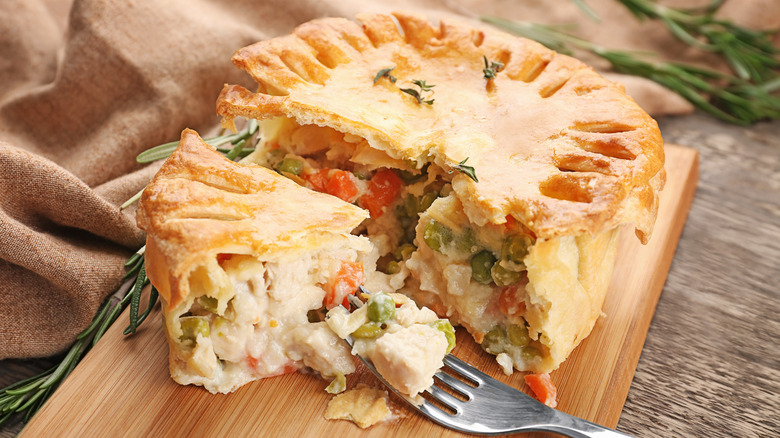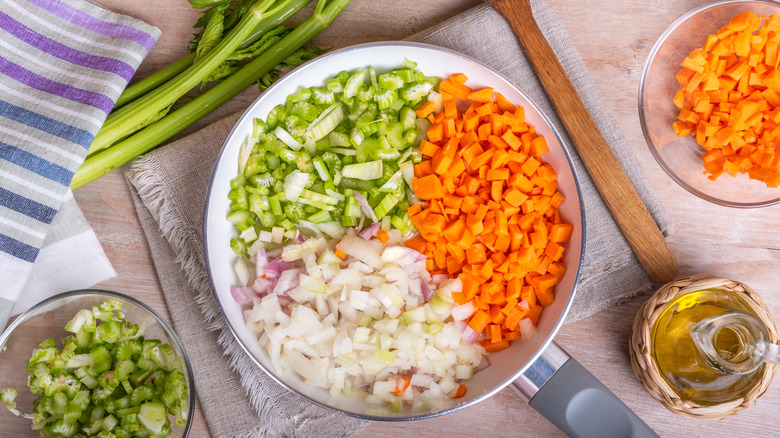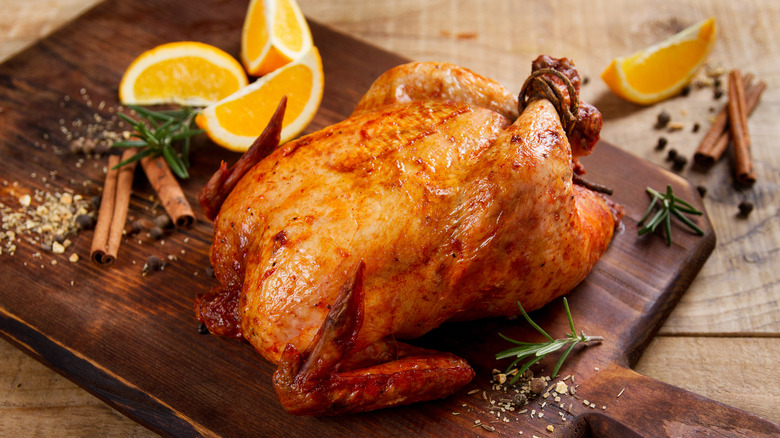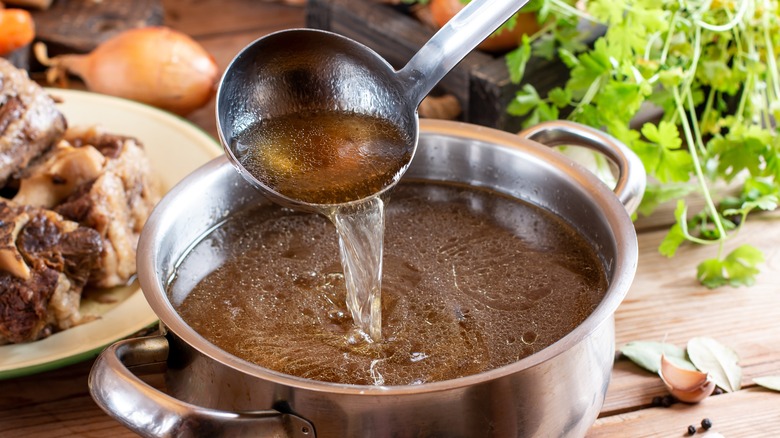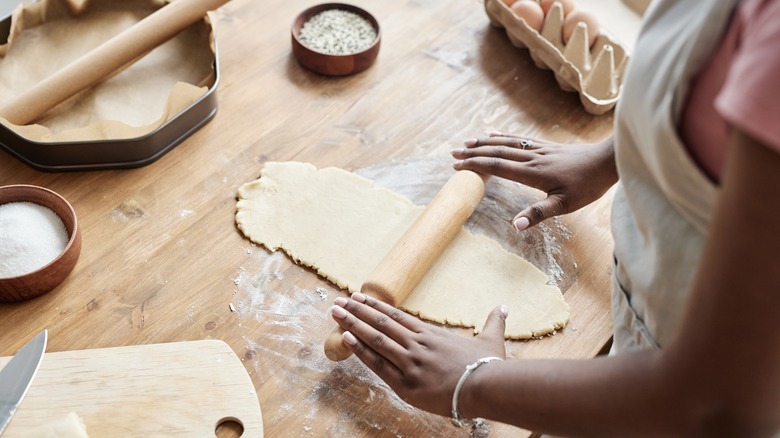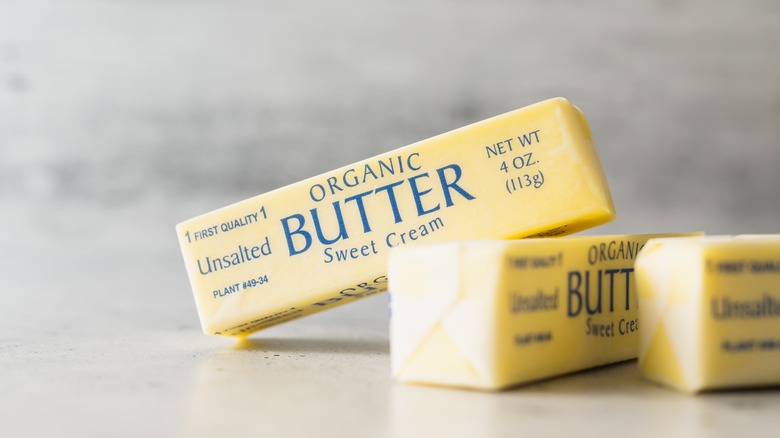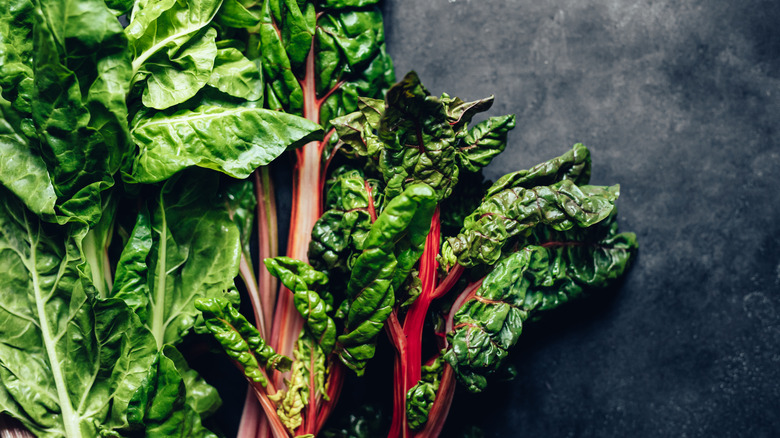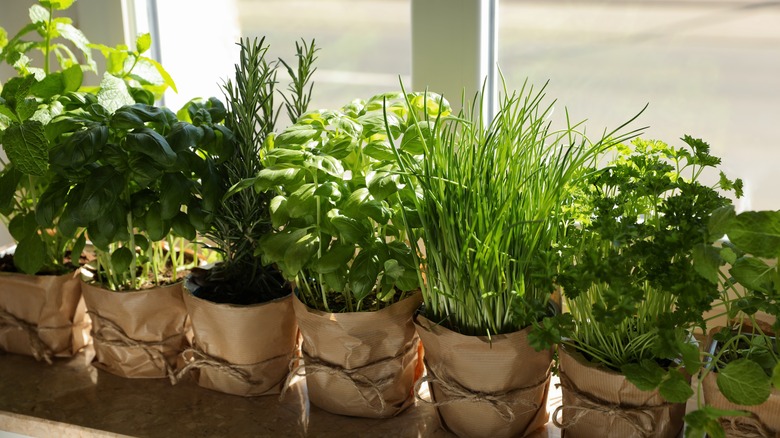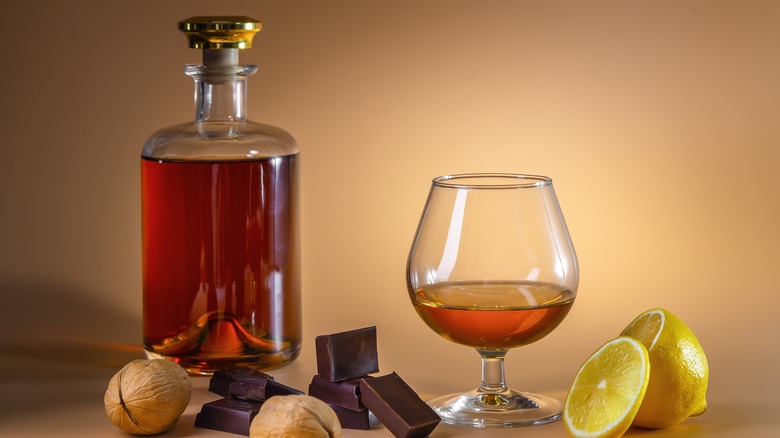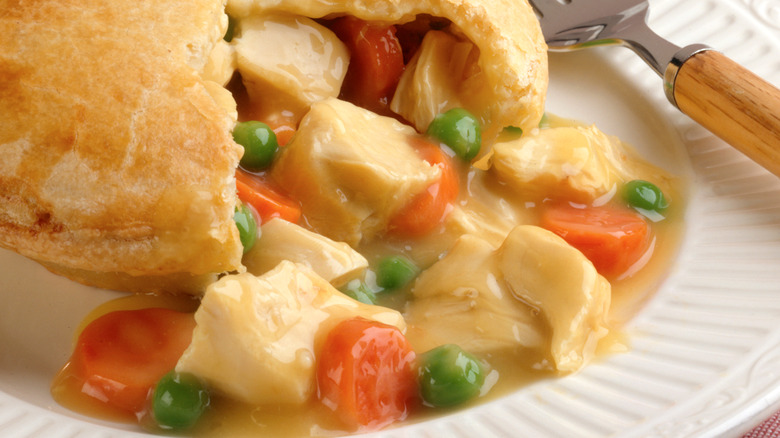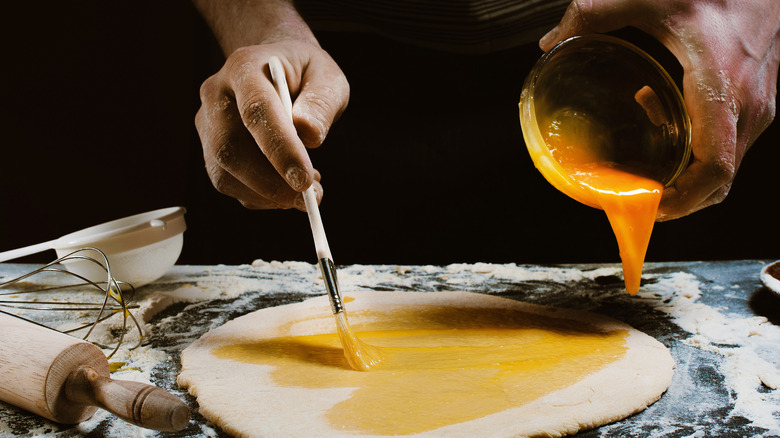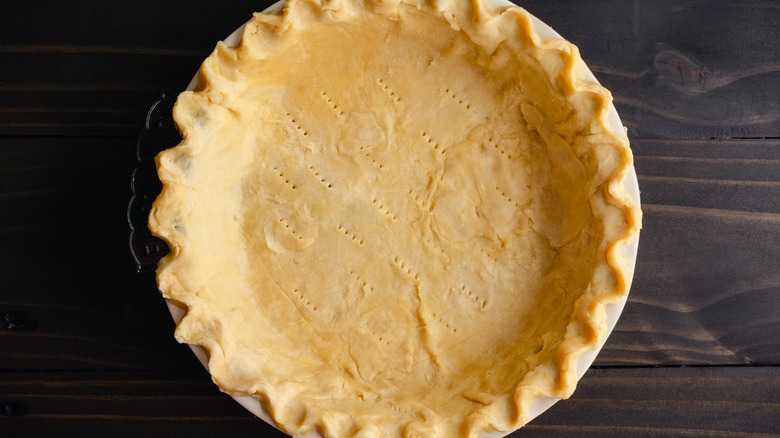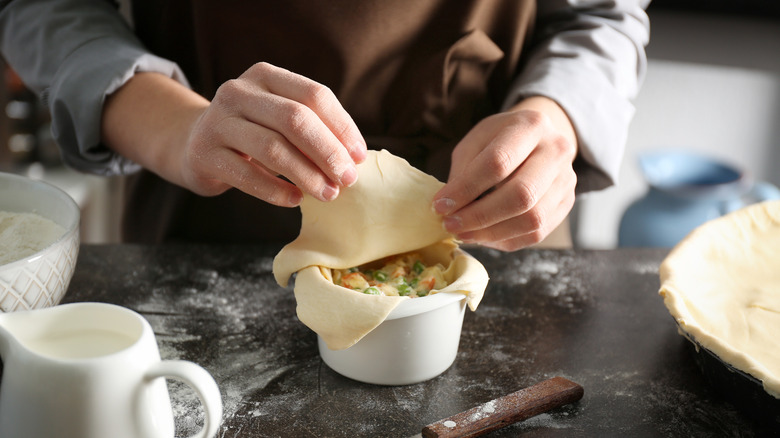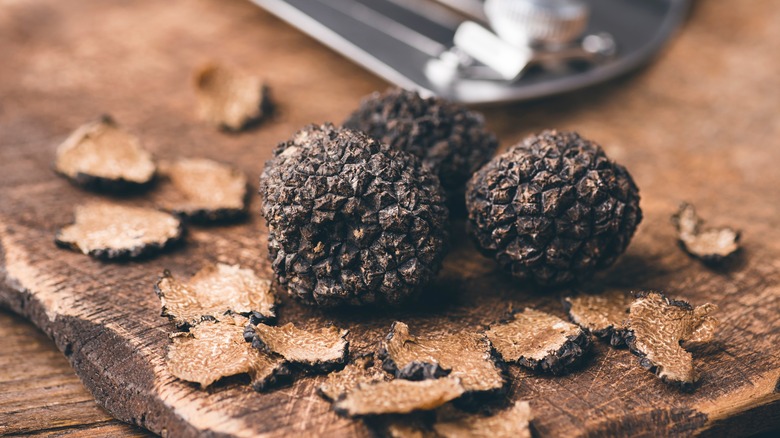Why Chicken Pot Pie Always Tastes Better At A Restaurant
If you love chicken pot pie, you may have tried making this classic comfort food dish at home only to find that it doesn't come close to the versions you've tried at restaurants. Maybe your crust is soggy, the sauce is bland, or the veggies just don't have the same appealing texture. If you're finding that even chain restaurant chicken pot pies are tasting better than your homemade attempts, it may be time to take a look at what chefs are doing to elevate theirs.
There are several reasons why chicken pot pie always tastes better at a restaurant. Most of these have to do with the choice of ingredients and cooking techniques used by professionals. Chefs know which cuts of chicken, vegetables, and sauce components to use to achieve the most flavorful, rich filling they can. They also know how to prep, construct, and bake the pie to get the perfect buttery, flaky crust and rich, velvety filling. If you're looking for some ways to upgrade your chicken pot pie, take note of a few of these hacks chefs use to create restaurant-quality dishes every time.
Fresh, quality ingredients are key
One thing that chefs typically don't waver on is using fresh ingredients whenever possible. Obviously, it can be a huge time-saver to use frozen or canned vegetables in your chicken pot pie. However, the truth is that processed foods can become mushy if they have been stored improperly or have been sitting in liquid for too long. The thawing process can be another reason why your frozen vegetables turn into a soggy mess. In addition, frozen and canned items can lose their color and even some of their original flavor. At the end of the day, nothing compares to fresh, vibrant veggies.
Quality is also key. A good chef will source the best ingredients they can, whether it's top-notch butter, veggies straight from the farm, or free-range chicken. Some chefs even go so far as to create relationships with local farmers and producers to ensure they get premium products in season or when they're at their peak. Chefs also know that local products can be fresher than those that have been imported.
When you're shopping for your ingredients, consider visiting your local farmer's market to get fresh vegetables from the source or your local butcher to get prime cuts of meat. If you can, choose quality over convenience and cost. Your chicken pot pie will thank you.
Chefs use the whole chicken
Home cooks may debate over whether chicken breasts or thighs are best for this comfort food dish, but some chefs will argue that only the whole bird will do for a Michelin-status chicken pot pie. Michelin-starred chef Paul Leonard told the Daily Mail that when he makes chicken pot pie, he roasts a whole chicken and then uses meat from all parts of the bird. He explained that the various bits impart different flavors to the pie. Whole roasted chicken meat also tends to be tastier and more tender than chicken breasts or thighs cooked separately thanks to the fat in the whole bird.
It's not just the juicy, flavorful meat from a whole-roasted chicken that can amp up the flavors of the pie. Leonard uses the juices from the chicken to make what he calls "a banging sauce." If you want to infuse more delicious chicken flavor into your homemade pie, you can use those juices and leftover bones to make homemade chicken stock to further boost the filling. You can also stir flour into a portion of the drippings to make a roux that will thicken your stock and help create a rich gravy.
Chefs make their chicken stock from scratch
As Anthony Bourdain wrote in Kitchen Confidential, "Stock is the backbone of good cooking." Many chefs wouldn't dream of using store-bought chicken stock in their chicken pot pie because it just doesn't have the same flavor as stock made in-house. Boxed or canned chicken stock can contain preservatives, artificial flavors, and sugar. Some store-bought chicken stocks are watered down, so they don't have as much natural chicken flavor. In addition, packaged stocks typically don't contain gelatin, which is what gives homemade stock its richness.
Making stock from scratch may sound daunting, but it's not actually that hard. The easiest way to make homemade chicken stock is with a classic slow cooker recipe. Basically, you just add the bones from one chicken; vegetables like carrots, onions, and celery; and some herbs in the slow cooker. Set the heat to low and cook for six hours. Cool the stock, strain it, and you have a delicious homemade stock you can add to your filling. If you don't have a slow cooker, try a classic chicken stock recipe that you can make on the stove. Making your own stock adds another step to the cooking process, but it's worth the time if you want your chicken pot pie to taste restaurant-quality.
Handmade pastry tastes better than store-bought pastry
Pastry is another chicken pot pie element that many chefs don't take shortcuts with. As cookbook author and The Great British Baking Show quarter-finalist, Benjamina Ebuehi, told The Guardian, "I like to encourage making your own pastry. You can taste the difference, and it's not as tricky or as time-consuming as people think, especially if you have a food processor."
Chefs typically make either shortcrust or puff pastry for their pies. Sturdier shortcrust is better for pies that need a full pastry case, while flakier puff pastry is better suited to pot pies that need only a lid.
Homemade pastry can be more flavorful and flakier than frozen pastry, but it can also be very time-consuming and labor-intensive. Homemade puff pastry needs to be mixed, rolled, chilled, and folded numerous times. Unless you're up for the challenge, you don't need to make puff pastry from scratch, as many store-bought versions taste great. If you can, use all-butter puff pastry, as it tends to rise better and will give you a wonderfully rich, buttery taste.
Chefs use cold butter to create a flaky crust
Perhaps you've tried to make your own pastry from scratch only to have it come out mushy or a bulletproof, hard mess. If so, you've probably made the classic puff pastry mistake. Chefs know that the key to flaky, light pastry is using cold butter because it helps creates those gorgeous layers in the dough. When the butter melts, steam escapes and creates pockets of air that give the dough its flaky character. On the other hand, butter that is too warm will melt into the dough. This could make your puff pastry greasy or your shortcrust tough.
To ensure your butter stays as cold as possible, it helps to do a bit of prep before pulling it out of the refrigerator. Some chefs recommend chilling your tools like the mixing bowl, cutting board, and rolling pin. You can also put your butter in the freezer for a bit until its nice and chilled and has a hard consistency. Some chefs also recommend chilling the pie crust and your filling before assembling the pie. The reason being, if you add hot filling to your pie crust, it could melt the butter in your pastry. This almost certainly will guarantee a soggy bottom.
Chefs avoid using watery vegetables
There's nothing worse than a wet, mushy chicken pot pie. One reason your favorite restaurant chicken pot pie may be so thick and hearty is because chefs tend to steer clear of watery vegetables like spinach or green beans, which tend to release a lot of liquid when they cook. Instead, use root vegetables that absorb liquid like carrots or potatoes. Other vegetables that have a high water content include zucchini, broccoli, and asparagus.
Another classic pot pie mistake many people make is not pre-cooking the vegetables before adding them to the filling. All vegetables contain some water, so if you add them directly to the filling without cooking them first, that water will seep into the pie. Cooking them beforehand allows some of that moisture to escape.
The only real exception to this guideline concerns frozen vegetables. Most frozen vegetables are blanched before being flash frozen, so they are already slightly cooked to begin with. Plus, the freezing process often changes the texture of the veggies, causing them to be less firm after they are thawed. Instead of pre-cooking them, add frozen vegetables at the end of the cooking process to prevent them from getting mushy.
Fresh herbs and aromatics amp up the flavor
If you've ever had chicken pot pie at a restaurant and wondered why it had so much more depth than your homemade version, it could be the aromatics. These are the spices, herbs, and vegetables that add layers of flavor and aromas to dishes. Chefs often cook aromatics in butter or olive oil to start off their chicken pot pie fillings. Some tie the aromatics in a bunch with cooking twine or create a small sachet to simmer them along with the chicken stock before removing.
Chefs often amp up their chicken pot pie filling with fresh herbs and spices to take it to the next level. For example, Rachael Ray uses fresh thyme and parsley, a bay leaf, and grated nutmeg in her recipe. Robert Irvine adds chopped, fresh tarragon and parsley to his turkey pot pie.
If you don't have fresh herbs on hand, you can substitute dried herbs for fresh. Just be aware that some herbs can have a more intense flavor when dried, so you'll need to use less than you would with fresh. A general rule of thumb is to use one teaspoon of dried herbs for tablespoon (three teaspoons) of fresh herbs.
A splash of cognac or wine can enhance the flavors
Another trick that chefs use to enhance their dishes is to add alcohol. Not only does this lend a boozy kick, but it can create new flavors and help certain ingredients cook better. Some flavor compounds are not soluble in water, but are broken down by alcohol, which more effectively bring out those unique flavors. In addition, alcohol may help break down proteins in meat, helping to tenderize it.
Many chefs add a splash of wine or spirits to their chicken pot pies to make them more decadent. Common alcohols used in chicken pot pies include cognac, white wine, dry vermouth and cooking sherry. Some chefs also add vodka to their pie crust because it helps give the pastry a texture that makes it easier to roll. It also contributes to a tender, flaky pie crust.
If you're planning on adding alcohol to your chicken pot pie filling, look for alcohols that are practically unflavored or more on the dry side. The last thing you want is a sickly sweet, fruit-flavored chicken pot pie.
Adding the thickening agent at the end makes for a richer gravy
Chefs and home cooks alike typically use flour to thicken up chicken pot pie filling so that it has a gravy-like consistency. Many chefs go one step further and create a roux to add to the sauce. A basic roux contains equal parts flour and some form of fat like butter, oil, or meat drippings. When cooked over low heat, this mixture creates a thickener that you can add to your chicken pot pie filling. Many recipes suggest adding the flour or roux after cooking the vegetables, but before adding the stock. However, some chefs believe that adding the roux at the very end of the cooking process yields better results.
That's because, if you add roux to your filling before the stock, it may thin out while the stock is simmering. In addition, pouring hot liquid onto a hot roux could cause it to separate, which might result in clumpy bits of flour in the middle of your pot pie.
The cooks who are in favor of the roux-last step often suggest making your roux ahead of time, letting it cool, and then adding it in the last 10 to 20 minutes. That gives it time to work its thickening magic and imparts a richer flavor to the filling.
Egg wash prevents the bottom from getting mushy
There is a lot of debate over whether or not chicken pot pie should have a bottom crust. Some people believe that a classic pot pie needs to have both a bottom and top crust, while others believe that the bottom is unnecessary and that it just gets soggy anyways. If you're in the bottom crust camp, do like chefs do and use an egg wash to keep the lower part of the pastry from getting mushy.
There are a number of reasons why you should use egg wash in your baking. The main one for chicken pot pie is that the egg wash can create a barrier between the bottom crust and the wet filling. Before adding the filling to your pie, simply crack an egg into a bowl and whisk it until the white part and yolk are fully incorporated. Then, use a pastry brush to paint a thin layer of egg wash on the bottom and sides of the pastry in your baking dish. You can also use the egg wash on the top crust to give it a beautiful golden brown tone and a glossy finish.
Some chefs blind bake their pie crust
Blind baking is another technique that chefs use to prevent the bottom crust from turning into a mushy mess. The technique involves baking the pie crust on its own before adding the filling. This helps the pie crust to crisp up a bit and prevents it from absorbing too much of the wet filling. It also ensures that the shell is fully cooked when the pie comes out of the oven. Additionally, it prevents steam from escaping and blowing out the crust while the assembled pie is cooking.
The biggest blind baking mistake people make with pies is not weighing down the crust before putting it in the oven. Otherwise, it may puff up and make filling the chicken pot pie difficult and messy. The best way to weight your crust is to place your bottom layer of pastry in your baking dish, press it to the sides, and cover it with a sheet of parchment paper.
Then add something heavy on top of the parchment paper. Many chefs use dried beans, but you can employ anything that's oven-safe like rice or another heavy baking dish. Cook the pastry at 350 degrees Fahrenheit for about 20 minutes until the crust is light golden, but not fully browned.
Chefs leave enough room for the filling to simmer
When it's time to assemble your chicken pot pie, it can be tempting to pile all of that luscious filling high. After all, the whole point is to make a hearty pie packed with delicious chicken, sauce, and veggies, right? There is a limit though. Most chefs will tell you to be careful not to overfill your pot pie. The reason is the filling will simmer and bubble while cooking, so you don't want it to ooze or burst out of the pie and cause a burnt mess at the bottom of your oven.
Instead, fill your chicken pot pie enough so that it's substantial, but be sure that you reserve enough space for the filling to expand and bubble. Some chefs suggest leaving about half an inch from the top of the baking dish to prevent it from bubbling over. You also want to make sure you have enough room to add that top layer of pastry and seal the edges. Using a knife to add vents in the top of the pastry will also allow steam to escape and prevent a potential pie explosion.
Some chefs add truffles to take the pie to the next level
Chefs don't shy away from using decadent ingredients to make their chicken pot pies that much more indulgent. For example, Wolfgang Puck set the culinary world abuzz when he added truffles to his chicken pot pie for the post-Oscars Governor's Ball in 2010. Truffles are a great add if you want to create a sumptuous, restaurant-quality chicken pot pie because they scream luxury and add a rich hit of umami that goes so well with the more traditional flavors of the pie.
Wolfgang Puck doesn't go easy on the truffles, either. According to The Art of Living, he adds chopped truffles, truffle oil, and truffle salt to his velouté (roux and chicken stock) and then grates more truffles into his filling.
Of course, this isn't a cheap addition. Considering how expensive truffles are and how powerful the flavor can be, you may want to start small with your truffle additions. Perhaps start with a few drops of truffle oil in the filling or a light dusting of shaved or grated truffles to the mix. Keep in mind that black truffles tend to have a richer flavor, while white truffles are more delicate.
